Corporate and Financial Accounting Report on Wesfarmers & Woolworths
VerifiedAdded on 2022/10/19
|13
|3268
|10
Report
AI Summary
This report provides a comprehensive analysis of the corporate and financial accounting practices of Wesfarmers and Woolworths, two prominent ASX-listed companies. The study focuses on how these companies raise funds to achieve their long-term objectives and maintain a strong market presence. The report delves into the owner's equity sections of both companies' balance sheets, examining movements over a three-year period from 2016 to 2018. It also analyzes the total liabilities sections, explaining the components and changes within these sections during the same timeframe. Furthermore, the report explores the concepts of small and large proprietary companies, outlining their compliance and reporting requirements. The analysis includes detailed examinations of common stock, retained earnings, treasury stock, and unrealized gains and losses, offering insights into the financial strategies and performance of Wesfarmers and Woolworths. The report highlights key trends, such as the impact of share issuances, dividend payments, and changes in debt levels on the companies' financial positions. The findings provide a clear understanding of the financial health and management strategies employed by these major corporations.
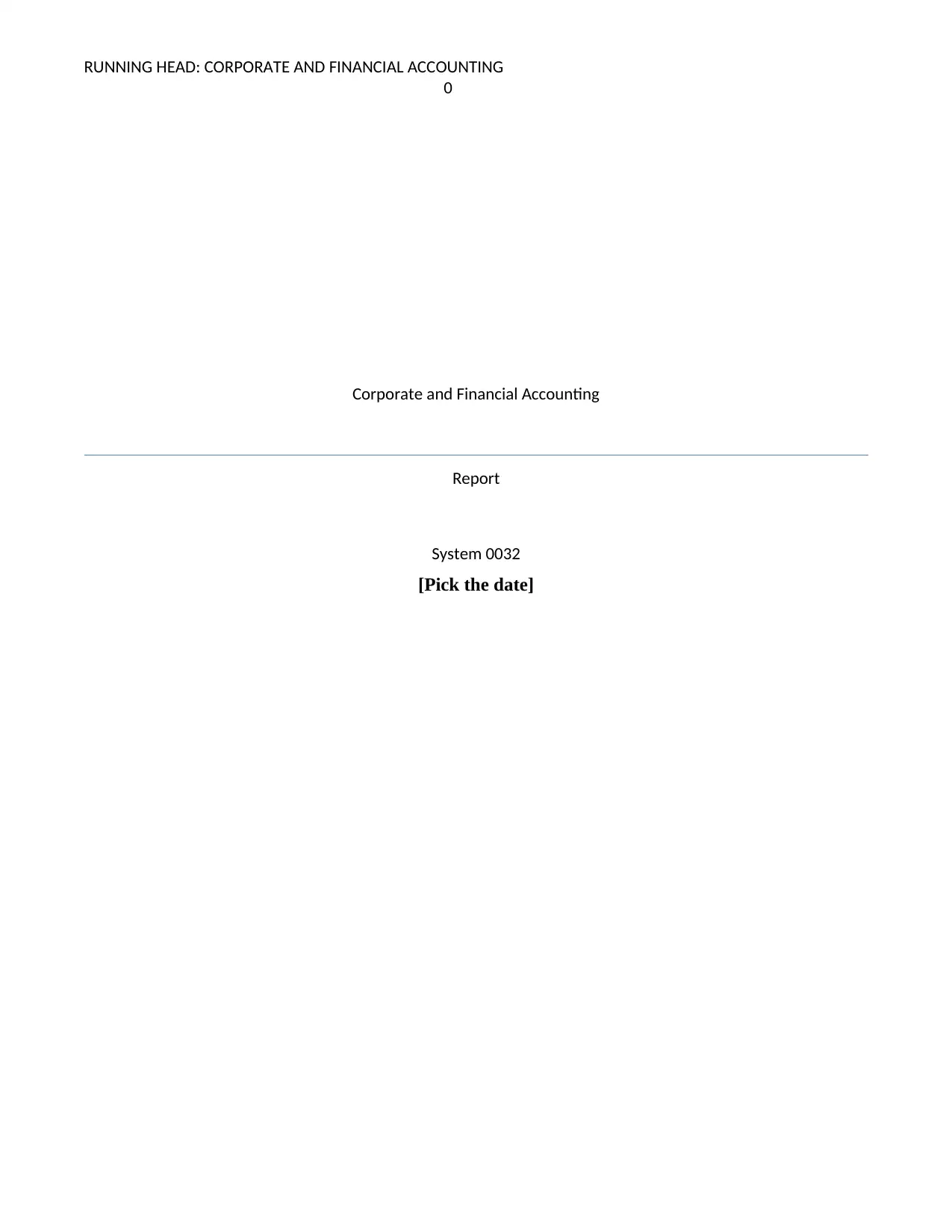
RUNNING HEAD: CORPORATE AND FINANCIAL ACCOUNTING
0
Corporate and Financial Accounting
Report
System 0032
[Pick the date]
0
Corporate and Financial Accounting
Report
System 0032
[Pick the date]
Paraphrase This Document
Need a fresh take? Get an instant paraphrase of this document with our AI Paraphraser
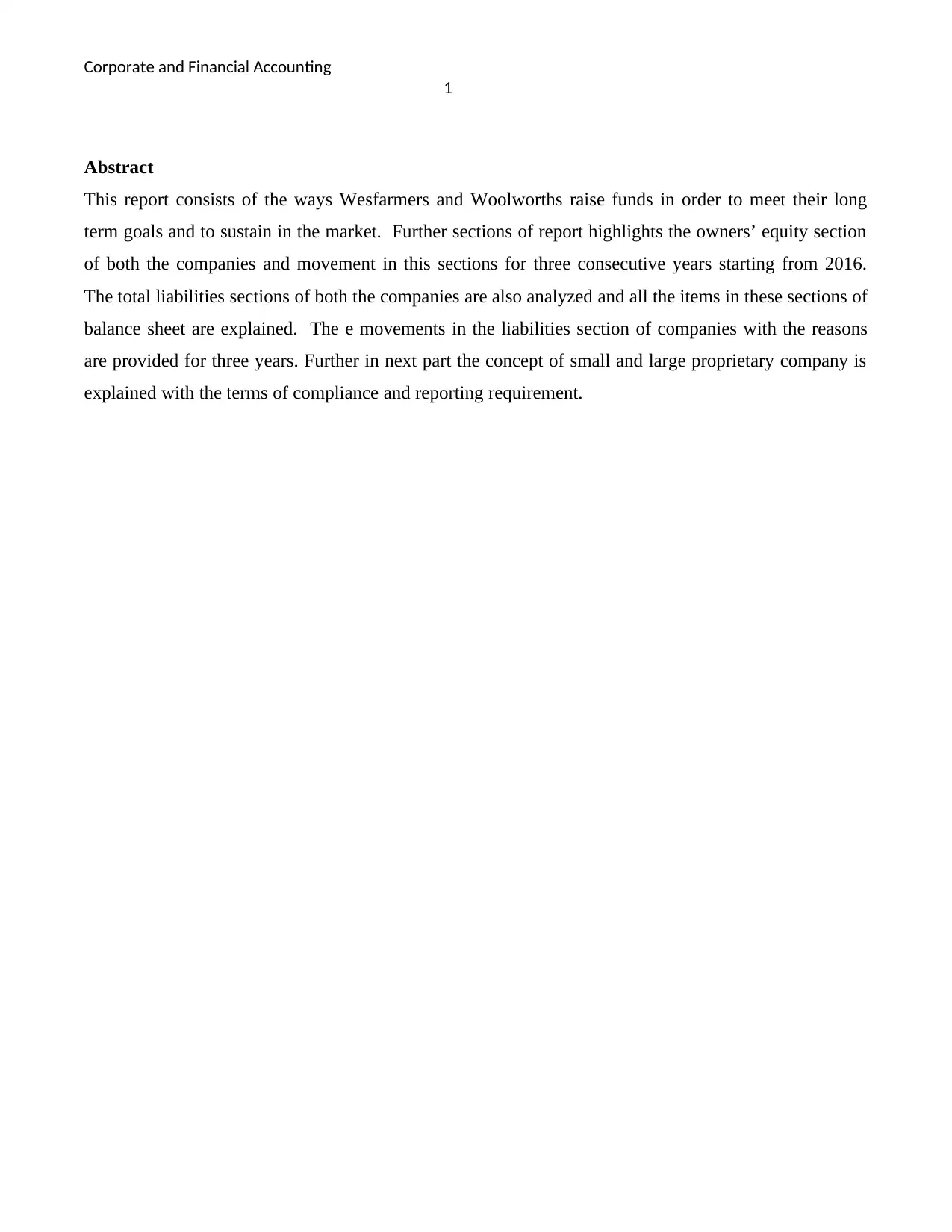
Corporate and Financial Accounting
1
Abstract
This report consists of the ways Wesfarmers and Woolworths raise funds in order to meet their long
term goals and to sustain in the market. Further sections of report highlights the owners’ equity section
of both the companies and movement in this sections for three consecutive years starting from 2016.
The total liabilities sections of both the companies are also analyzed and all the items in these sections of
balance sheet are explained. The e movements in the liabilities section of companies with the reasons
are provided for three years. Further in next part the concept of small and large proprietary company is
explained with the terms of compliance and reporting requirement.
1
Abstract
This report consists of the ways Wesfarmers and Woolworths raise funds in order to meet their long
term goals and to sustain in the market. Further sections of report highlights the owners’ equity section
of both the companies and movement in this sections for three consecutive years starting from 2016.
The total liabilities sections of both the companies are also analyzed and all the items in these sections of
balance sheet are explained. The e movements in the liabilities section of companies with the reasons
are provided for three years. Further in next part the concept of small and large proprietary company is
explained with the terms of compliance and reporting requirement.
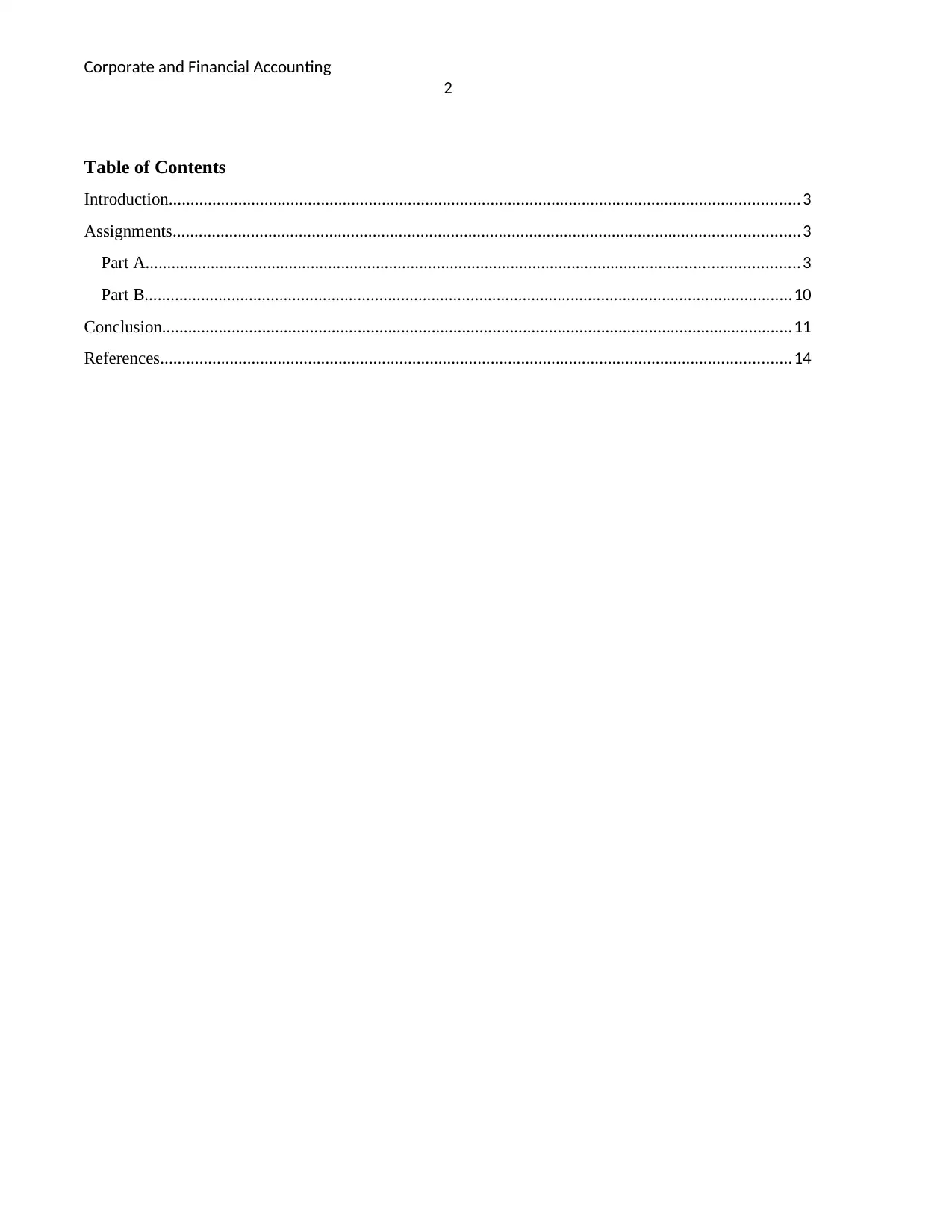
Corporate and Financial Accounting
2
Table of Contents
Introduction.................................................................................................................................................3
Assignments................................................................................................................................................3
Part A......................................................................................................................................................3
Part B.....................................................................................................................................................10
Conclusion.................................................................................................................................................11
References.................................................................................................................................................14
2
Table of Contents
Introduction.................................................................................................................................................3
Assignments................................................................................................................................................3
Part A......................................................................................................................................................3
Part B.....................................................................................................................................................10
Conclusion.................................................................................................................................................11
References.................................................................................................................................................14
⊘ This is a preview!⊘
Do you want full access?
Subscribe today to unlock all pages.

Trusted by 1+ million students worldwide
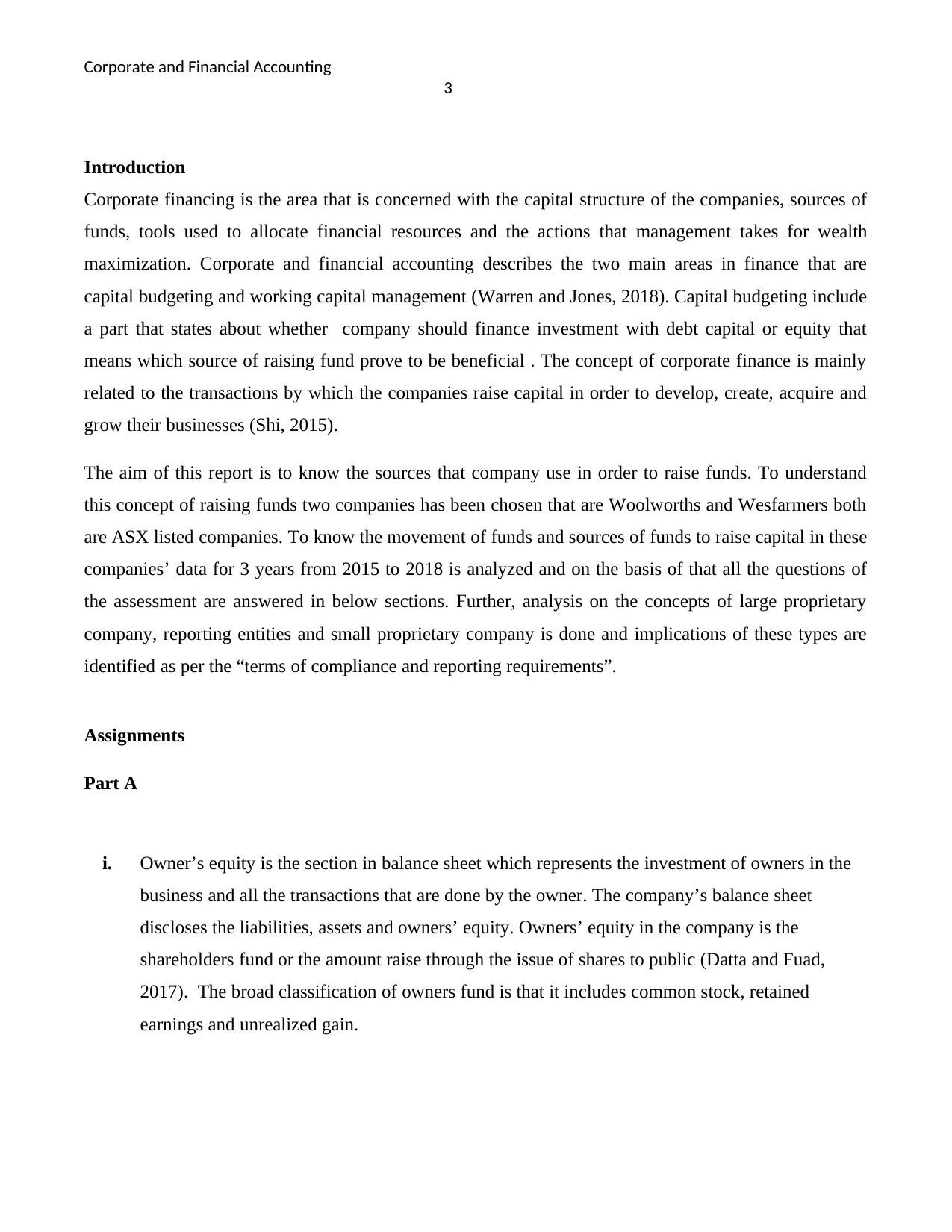
Corporate and Financial Accounting
3
Introduction
Corporate financing is the area that is concerned with the capital structure of the companies, sources of
funds, tools used to allocate financial resources and the actions that management takes for wealth
maximization. Corporate and financial accounting describes the two main areas in finance that are
capital budgeting and working capital management (Warren and Jones, 2018). Capital budgeting include
a part that states about whether company should finance investment with debt capital or equity that
means which source of raising fund prove to be beneficial . The concept of corporate finance is mainly
related to the transactions by which the companies raise capital in order to develop, create, acquire and
grow their businesses (Shi, 2015).
The aim of this report is to know the sources that company use in order to raise funds. To understand
this concept of raising funds two companies has been chosen that are Woolworths and Wesfarmers both
are ASX listed companies. To know the movement of funds and sources of funds to raise capital in these
companies’ data for 3 years from 2015 to 2018 is analyzed and on the basis of that all the questions of
the assessment are answered in below sections. Further, analysis on the concepts of large proprietary
company, reporting entities and small proprietary company is done and implications of these types are
identified as per the “terms of compliance and reporting requirements”.
Assignments
Part A
i. Owner’s equity is the section in balance sheet which represents the investment of owners in the
business and all the transactions that are done by the owner. The company’s balance sheet
discloses the liabilities, assets and owners’ equity. Owners’ equity in the company is the
shareholders fund or the amount raise through the issue of shares to public (Datta and Fuad,
2017). The broad classification of owners fund is that it includes common stock, retained
earnings and unrealized gain.
3
Introduction
Corporate financing is the area that is concerned with the capital structure of the companies, sources of
funds, tools used to allocate financial resources and the actions that management takes for wealth
maximization. Corporate and financial accounting describes the two main areas in finance that are
capital budgeting and working capital management (Warren and Jones, 2018). Capital budgeting include
a part that states about whether company should finance investment with debt capital or equity that
means which source of raising fund prove to be beneficial . The concept of corporate finance is mainly
related to the transactions by which the companies raise capital in order to develop, create, acquire and
grow their businesses (Shi, 2015).
The aim of this report is to know the sources that company use in order to raise funds. To understand
this concept of raising funds two companies has been chosen that are Woolworths and Wesfarmers both
are ASX listed companies. To know the movement of funds and sources of funds to raise capital in these
companies’ data for 3 years from 2015 to 2018 is analyzed and on the basis of that all the questions of
the assessment are answered in below sections. Further, analysis on the concepts of large proprietary
company, reporting entities and small proprietary company is done and implications of these types are
identified as per the “terms of compliance and reporting requirements”.
Assignments
Part A
i. Owner’s equity is the section in balance sheet which represents the investment of owners in the
business and all the transactions that are done by the owner. The company’s balance sheet
discloses the liabilities, assets and owners’ equity. Owners’ equity in the company is the
shareholders fund or the amount raise through the issue of shares to public (Datta and Fuad,
2017). The broad classification of owners fund is that it includes common stock, retained
earnings and unrealized gain.
Paraphrase This Document
Need a fresh take? Get an instant paraphrase of this document with our AI Paraphraser
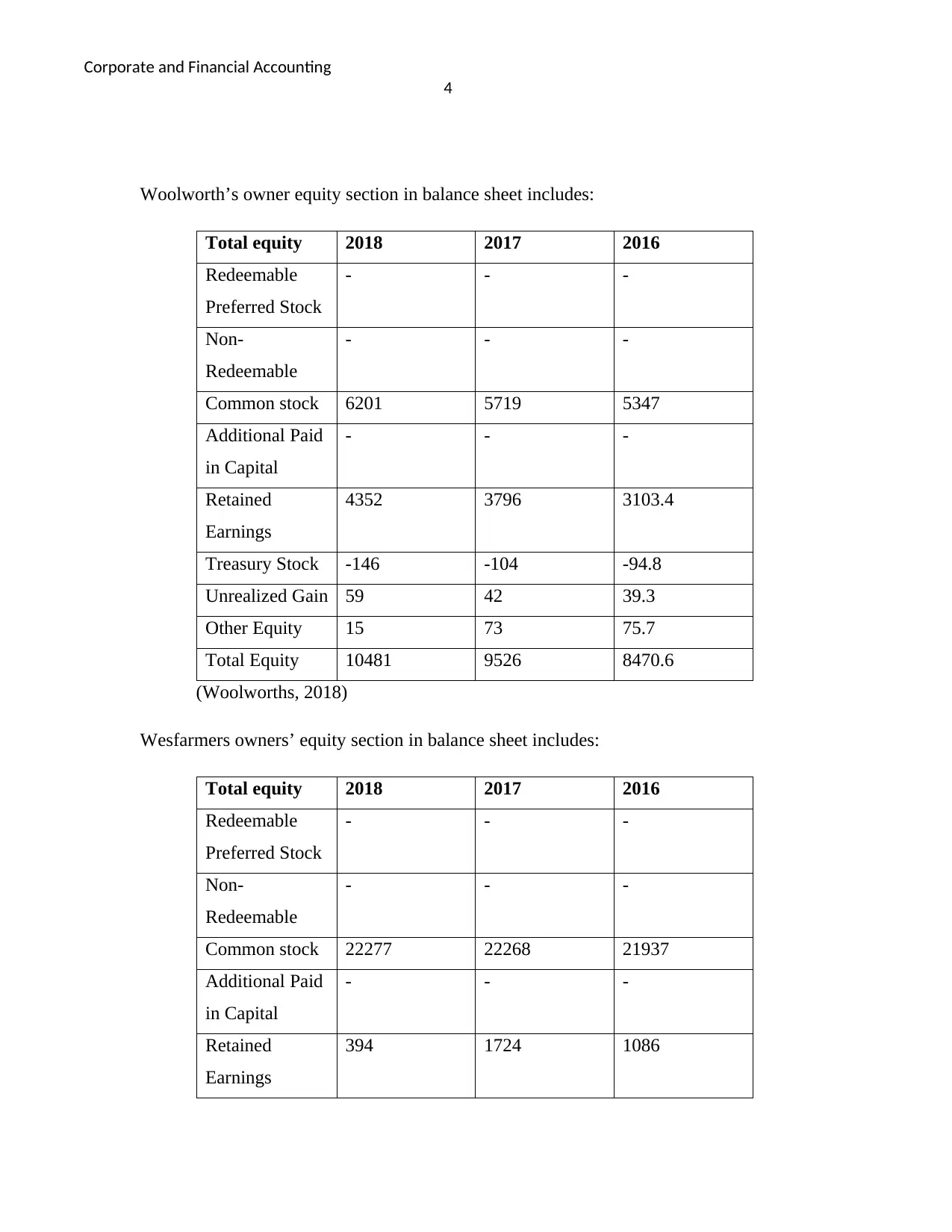
Corporate and Financial Accounting
4
Woolworth’s owner equity section in balance sheet includes:
Total equity 2018 2017 2016
Redeemable
Preferred Stock
- - -
Non-
Redeemable
- - -
Common stock 6201 5719 5347
Additional Paid
in Capital
- - -
Retained
Earnings
4352 3796 3103.4
Treasury Stock -146 -104 -94.8
Unrealized Gain 59 42 39.3
Other Equity 15 73 75.7
Total Equity 10481 9526 8470.6
(Woolworths, 2018)
Wesfarmers owners’ equity section in balance sheet includes:
Total equity 2018 2017 2016
Redeemable
Preferred Stock
- - -
Non-
Redeemable
- - -
Common stock 22277 22268 21937
Additional Paid
in Capital
- - -
Retained
Earnings
394 1724 1086
4
Woolworth’s owner equity section in balance sheet includes:
Total equity 2018 2017 2016
Redeemable
Preferred Stock
- - -
Non-
Redeemable
- - -
Common stock 6201 5719 5347
Additional Paid
in Capital
- - -
Retained
Earnings
4352 3796 3103.4
Treasury Stock -146 -104 -94.8
Unrealized Gain 59 42 39.3
Other Equity 15 73 75.7
Total Equity 10481 9526 8470.6
(Woolworths, 2018)
Wesfarmers owners’ equity section in balance sheet includes:
Total equity 2018 2017 2016
Redeemable
Preferred Stock
- - -
Non-
Redeemable
- - -
Common stock 22277 22268 21937
Additional Paid
in Capital
- - -
Retained
Earnings
394 1724 1086
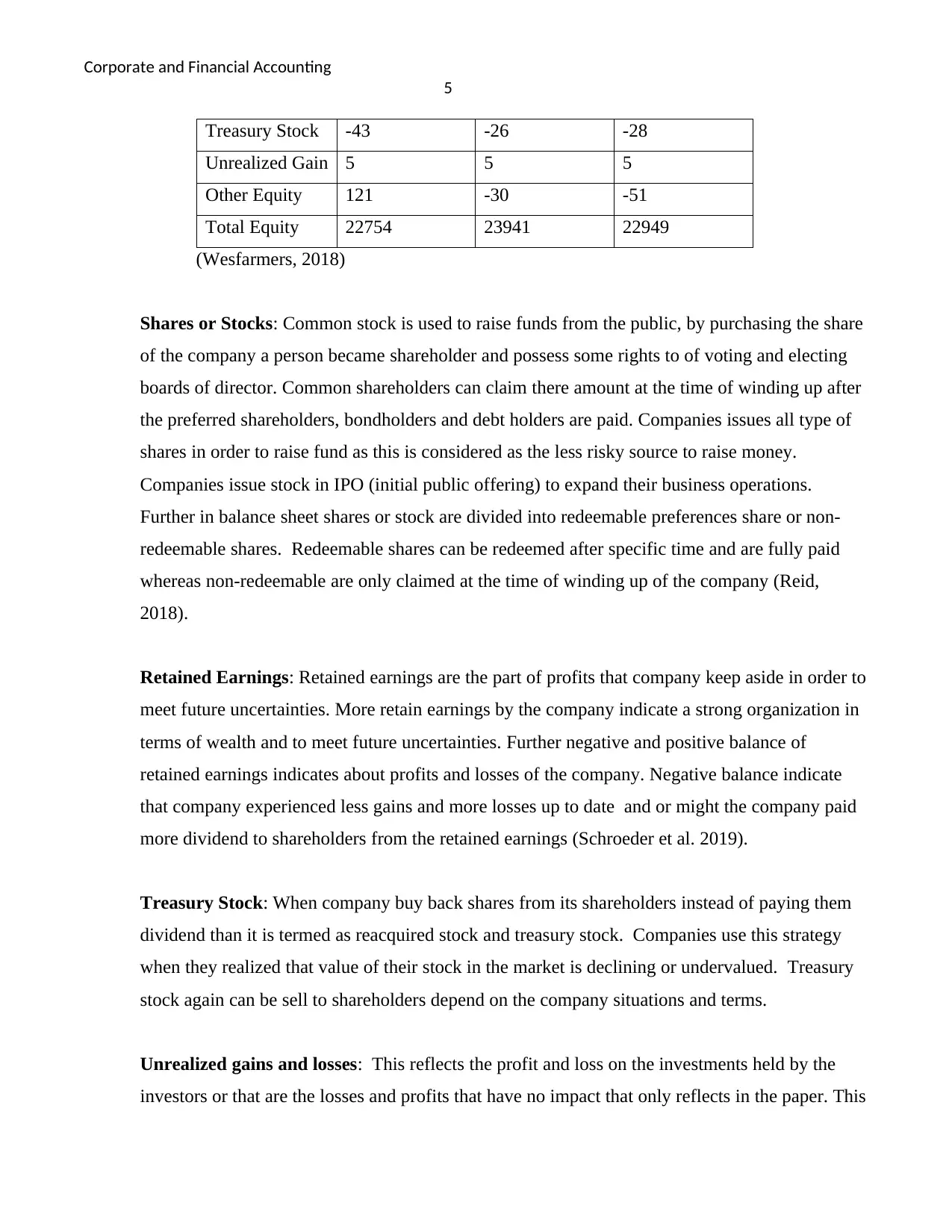
Corporate and Financial Accounting
5
Treasury Stock -43 -26 -28
Unrealized Gain 5 5 5
Other Equity 121 -30 -51
Total Equity 22754 23941 22949
(Wesfarmers, 2018)
Shares or Stocks: Common stock is used to raise funds from the public, by purchasing the share
of the company a person became shareholder and possess some rights to of voting and electing
boards of director. Common shareholders can claim there amount at the time of winding up after
the preferred shareholders, bondholders and debt holders are paid. Companies issues all type of
shares in order to raise fund as this is considered as the less risky source to raise money.
Companies issue stock in IPO (initial public offering) to expand their business operations.
Further in balance sheet shares or stock are divided into redeemable preferences share or non-
redeemable shares. Redeemable shares can be redeemed after specific time and are fully paid
whereas non-redeemable are only claimed at the time of winding up of the company (Reid,
2018).
Retained Earnings: Retained earnings are the part of profits that company keep aside in order to
meet future uncertainties. More retain earnings by the company indicate a strong organization in
terms of wealth and to meet future uncertainties. Further negative and positive balance of
retained earnings indicates about profits and losses of the company. Negative balance indicate
that company experienced less gains and more losses up to date and or might the company paid
more dividend to shareholders from the retained earnings (Schroeder et al. 2019).
Treasury Stock: When company buy back shares from its shareholders instead of paying them
dividend than it is termed as reacquired stock and treasury stock. Companies use this strategy
when they realized that value of their stock in the market is declining or undervalued. Treasury
stock again can be sell to shareholders depend on the company situations and terms.
Unrealized gains and losses: This reflects the profit and loss on the investments held by the
investors or that are the losses and profits that have no impact that only reflects in the paper. This
5
Treasury Stock -43 -26 -28
Unrealized Gain 5 5 5
Other Equity 121 -30 -51
Total Equity 22754 23941 22949
(Wesfarmers, 2018)
Shares or Stocks: Common stock is used to raise funds from the public, by purchasing the share
of the company a person became shareholder and possess some rights to of voting and electing
boards of director. Common shareholders can claim there amount at the time of winding up after
the preferred shareholders, bondholders and debt holders are paid. Companies issues all type of
shares in order to raise fund as this is considered as the less risky source to raise money.
Companies issue stock in IPO (initial public offering) to expand their business operations.
Further in balance sheet shares or stock are divided into redeemable preferences share or non-
redeemable shares. Redeemable shares can be redeemed after specific time and are fully paid
whereas non-redeemable are only claimed at the time of winding up of the company (Reid,
2018).
Retained Earnings: Retained earnings are the part of profits that company keep aside in order to
meet future uncertainties. More retain earnings by the company indicate a strong organization in
terms of wealth and to meet future uncertainties. Further negative and positive balance of
retained earnings indicates about profits and losses of the company. Negative balance indicate
that company experienced less gains and more losses up to date and or might the company paid
more dividend to shareholders from the retained earnings (Schroeder et al. 2019).
Treasury Stock: When company buy back shares from its shareholders instead of paying them
dividend than it is termed as reacquired stock and treasury stock. Companies use this strategy
when they realized that value of their stock in the market is declining or undervalued. Treasury
stock again can be sell to shareholders depend on the company situations and terms.
Unrealized gains and losses: This reflects the profit and loss on the investments held by the
investors or that are the losses and profits that have no impact that only reflects in the paper. This
⊘ This is a preview!⊘
Do you want full access?
Subscribe today to unlock all pages.

Trusted by 1+ million students worldwide
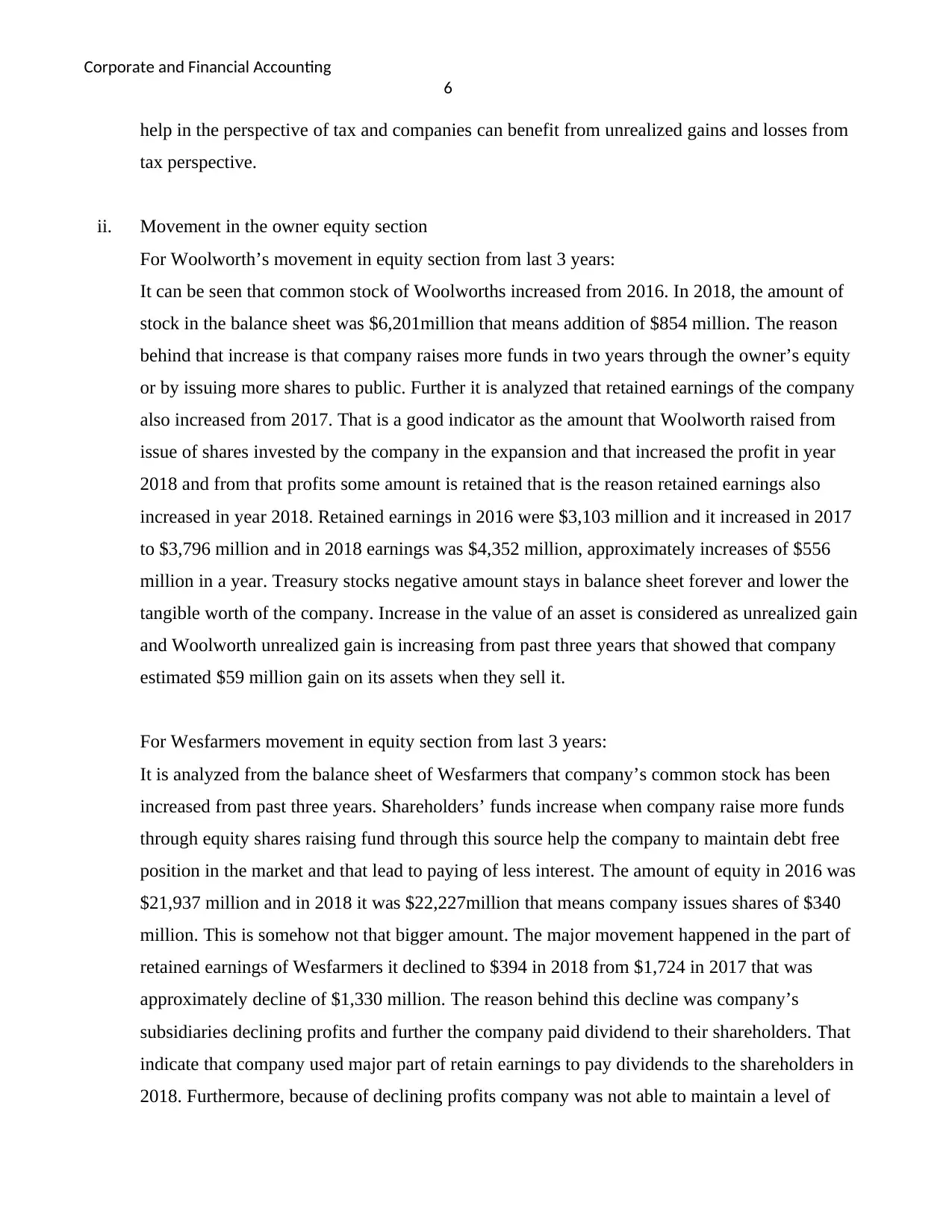
Corporate and Financial Accounting
6
help in the perspective of tax and companies can benefit from unrealized gains and losses from
tax perspective.
ii. Movement in the owner equity section
For Woolworth’s movement in equity section from last 3 years:
It can be seen that common stock of Woolworths increased from 2016. In 2018, the amount of
stock in the balance sheet was $6,201million that means addition of $854 million. The reason
behind that increase is that company raises more funds in two years through the owner’s equity
or by issuing more shares to public. Further it is analyzed that retained earnings of the company
also increased from 2017. That is a good indicator as the amount that Woolworth raised from
issue of shares invested by the company in the expansion and that increased the profit in year
2018 and from that profits some amount is retained that is the reason retained earnings also
increased in year 2018. Retained earnings in 2016 were $3,103 million and it increased in 2017
to $3,796 million and in 2018 earnings was $4,352 million, approximately increases of $556
million in a year. Treasury stocks negative amount stays in balance sheet forever and lower the
tangible worth of the company. Increase in the value of an asset is considered as unrealized gain
and Woolworth unrealized gain is increasing from past three years that showed that company
estimated $59 million gain on its assets when they sell it.
For Wesfarmers movement in equity section from last 3 years:
It is analyzed from the balance sheet of Wesfarmers that company’s common stock has been
increased from past three years. Shareholders’ funds increase when company raise more funds
through equity shares raising fund through this source help the company to maintain debt free
position in the market and that lead to paying of less interest. The amount of equity in 2016 was
$21,937 million and in 2018 it was $22,227million that means company issues shares of $340
million. This is somehow not that bigger amount. The major movement happened in the part of
retained earnings of Wesfarmers it declined to $394 in 2018 from $1,724 in 2017 that was
approximately decline of $1,330 million. The reason behind this decline was company’s
subsidiaries declining profits and further the company paid dividend to their shareholders. That
indicate that company used major part of retain earnings to pay dividends to the shareholders in
2018. Furthermore, because of declining profits company was not able to maintain a level of
6
help in the perspective of tax and companies can benefit from unrealized gains and losses from
tax perspective.
ii. Movement in the owner equity section
For Woolworth’s movement in equity section from last 3 years:
It can be seen that common stock of Woolworths increased from 2016. In 2018, the amount of
stock in the balance sheet was $6,201million that means addition of $854 million. The reason
behind that increase is that company raises more funds in two years through the owner’s equity
or by issuing more shares to public. Further it is analyzed that retained earnings of the company
also increased from 2017. That is a good indicator as the amount that Woolworth raised from
issue of shares invested by the company in the expansion and that increased the profit in year
2018 and from that profits some amount is retained that is the reason retained earnings also
increased in year 2018. Retained earnings in 2016 were $3,103 million and it increased in 2017
to $3,796 million and in 2018 earnings was $4,352 million, approximately increases of $556
million in a year. Treasury stocks negative amount stays in balance sheet forever and lower the
tangible worth of the company. Increase in the value of an asset is considered as unrealized gain
and Woolworth unrealized gain is increasing from past three years that showed that company
estimated $59 million gain on its assets when they sell it.
For Wesfarmers movement in equity section from last 3 years:
It is analyzed from the balance sheet of Wesfarmers that company’s common stock has been
increased from past three years. Shareholders’ funds increase when company raise more funds
through equity shares raising fund through this source help the company to maintain debt free
position in the market and that lead to paying of less interest. The amount of equity in 2016 was
$21,937 million and in 2018 it was $22,227million that means company issues shares of $340
million. This is somehow not that bigger amount. The major movement happened in the part of
retained earnings of Wesfarmers it declined to $394 in 2018 from $1,724 in 2017 that was
approximately decline of $1,330 million. The reason behind this decline was company’s
subsidiaries declining profits and further the company paid dividend to their shareholders. That
indicate that company used major part of retain earnings to pay dividends to the shareholders in
2018. Furthermore, because of declining profits company was not able to maintain a level of
Paraphrase This Document
Need a fresh take? Get an instant paraphrase of this document with our AI Paraphraser
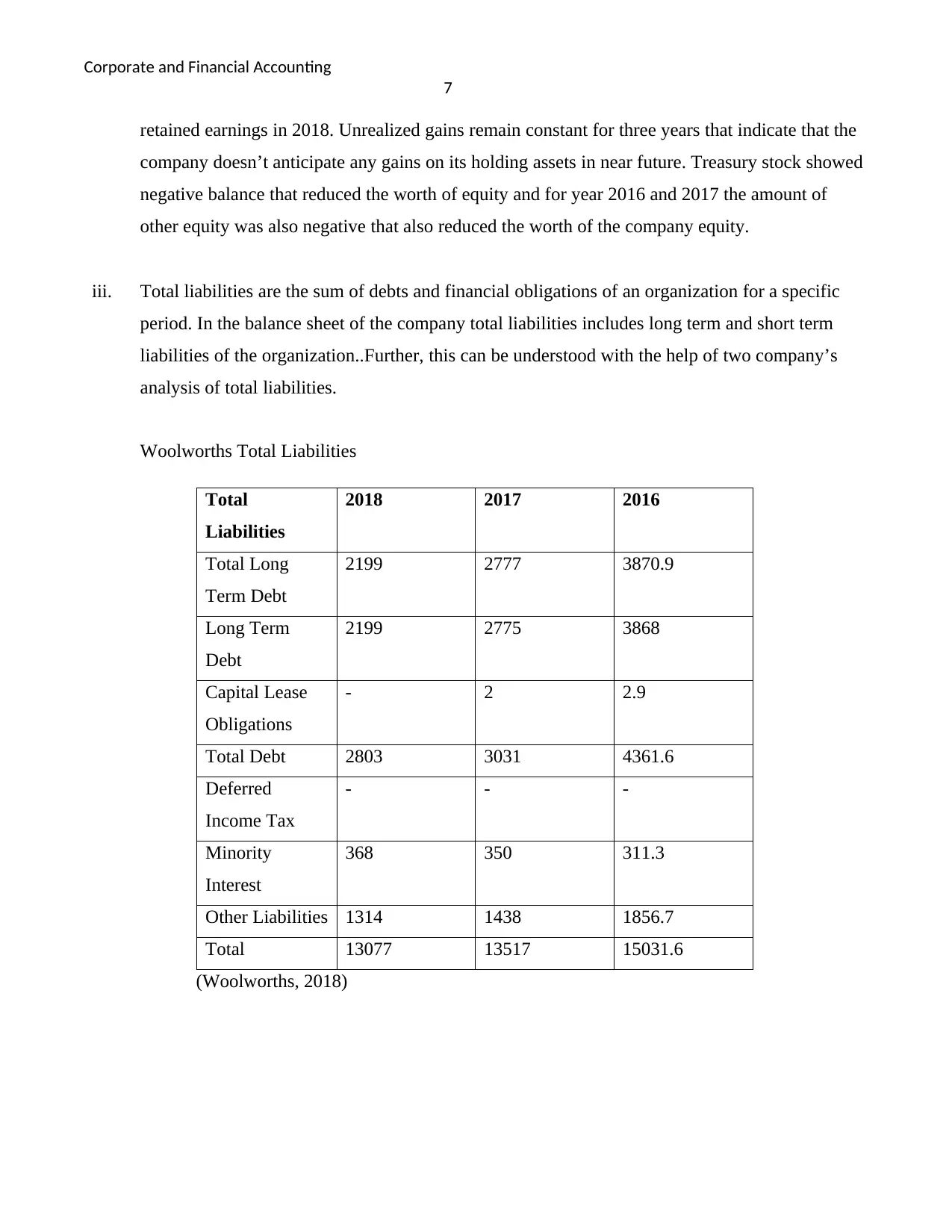
Corporate and Financial Accounting
7
retained earnings in 2018. Unrealized gains remain constant for three years that indicate that the
company doesn’t anticipate any gains on its holding assets in near future. Treasury stock showed
negative balance that reduced the worth of equity and for year 2016 and 2017 the amount of
other equity was also negative that also reduced the worth of the company equity.
iii. Total liabilities are the sum of debts and financial obligations of an organization for a specific
period. In the balance sheet of the company total liabilities includes long term and short term
liabilities of the organization..Further, this can be understood with the help of two company’s
analysis of total liabilities.
Woolworths Total Liabilities
Total
Liabilities
2018 2017 2016
Total Long
Term Debt
2199 2777 3870.9
Long Term
Debt
2199 2775 3868
Capital Lease
Obligations
- 2 2.9
Total Debt 2803 3031 4361.6
Deferred
Income Tax
- - -
Minority
Interest
368 350 311.3
Other Liabilities 1314 1438 1856.7
Total 13077 13517 15031.6
(Woolworths, 2018)
7
retained earnings in 2018. Unrealized gains remain constant for three years that indicate that the
company doesn’t anticipate any gains on its holding assets in near future. Treasury stock showed
negative balance that reduced the worth of equity and for year 2016 and 2017 the amount of
other equity was also negative that also reduced the worth of the company equity.
iii. Total liabilities are the sum of debts and financial obligations of an organization for a specific
period. In the balance sheet of the company total liabilities includes long term and short term
liabilities of the organization..Further, this can be understood with the help of two company’s
analysis of total liabilities.
Woolworths Total Liabilities
Total
Liabilities
2018 2017 2016
Total Long
Term Debt
2199 2777 3870.9
Long Term
Debt
2199 2775 3868
Capital Lease
Obligations
- 2 2.9
Total Debt 2803 3031 4361.6
Deferred
Income Tax
- - -
Minority
Interest
368 350 311.3
Other Liabilities 1314 1438 1856.7
Total 13077 13517 15031.6
(Woolworths, 2018)
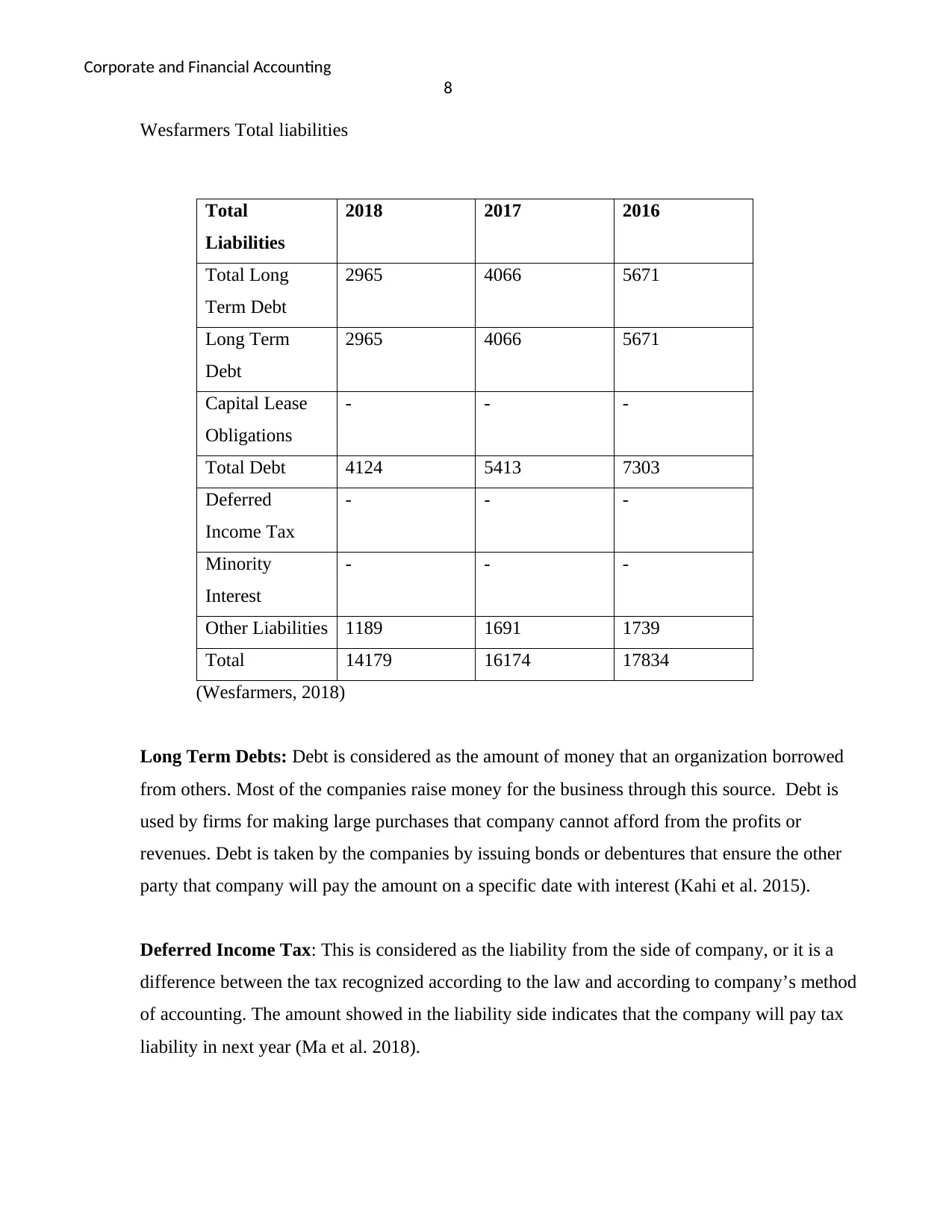
Corporate and Financial Accounting
8
Wesfarmers Total liabilities
Total
Liabilities
2018 2017 2016
Total Long
Term Debt
2965 4066 5671
Long Term
Debt
2965 4066 5671
Capital Lease
Obligations
- - -
Total Debt 4124 5413 7303
Deferred
Income Tax
- - -
Minority
Interest
- - -
Other Liabilities 1189 1691 1739
Total 14179 16174 17834
(Wesfarmers, 2018)
Long Term Debts: Debt is considered as the amount of money that an organization borrowed
from others. Most of the companies raise money for the business through this source. Debt is
used by firms for making large purchases that company cannot afford from the profits or
revenues. Debt is taken by the companies by issuing bonds or debentures that ensure the other
party that company will pay the amount on a specific date with interest (Kahi et al. 2015).
Deferred Income Tax: This is considered as the liability from the side of company, or it is a
difference between the tax recognized according to the law and according to company’s method
of accounting. The amount showed in the liability side indicates that the company will pay tax
liability in next year (Ma et al. 2018).
8
Wesfarmers Total liabilities
Total
Liabilities
2018 2017 2016
Total Long
Term Debt
2965 4066 5671
Long Term
Debt
2965 4066 5671
Capital Lease
Obligations
- - -
Total Debt 4124 5413 7303
Deferred
Income Tax
- - -
Minority
Interest
- - -
Other Liabilities 1189 1691 1739
Total 14179 16174 17834
(Wesfarmers, 2018)
Long Term Debts: Debt is considered as the amount of money that an organization borrowed
from others. Most of the companies raise money for the business through this source. Debt is
used by firms for making large purchases that company cannot afford from the profits or
revenues. Debt is taken by the companies by issuing bonds or debentures that ensure the other
party that company will pay the amount on a specific date with interest (Kahi et al. 2015).
Deferred Income Tax: This is considered as the liability from the side of company, or it is a
difference between the tax recognized according to the law and according to company’s method
of accounting. The amount showed in the liability side indicates that the company will pay tax
liability in next year (Ma et al. 2018).
⊘ This is a preview!⊘
Do you want full access?
Subscribe today to unlock all pages.

Trusted by 1+ million students worldwide
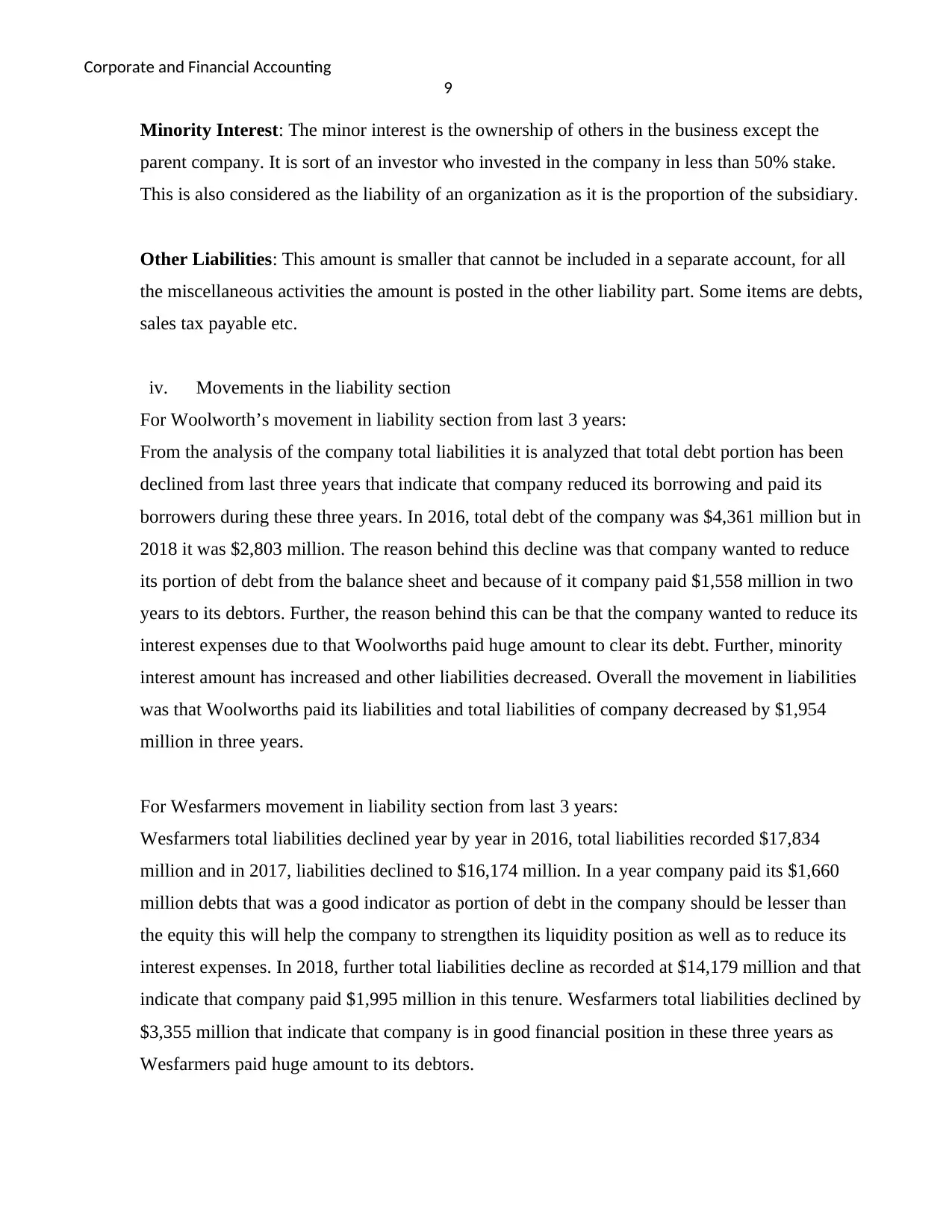
Corporate and Financial Accounting
9
Minority Interest: The minor interest is the ownership of others in the business except the
parent company. It is sort of an investor who invested in the company in less than 50% stake.
This is also considered as the liability of an organization as it is the proportion of the subsidiary.
Other Liabilities: This amount is smaller that cannot be included in a separate account, for all
the miscellaneous activities the amount is posted in the other liability part. Some items are debts,
sales tax payable etc.
iv. Movements in the liability section
For Woolworth’s movement in liability section from last 3 years:
From the analysis of the company total liabilities it is analyzed that total debt portion has been
declined from last three years that indicate that company reduced its borrowing and paid its
borrowers during these three years. In 2016, total debt of the company was $4,361 million but in
2018 it was $2,803 million. The reason behind this decline was that company wanted to reduce
its portion of debt from the balance sheet and because of it company paid $1,558 million in two
years to its debtors. Further, the reason behind this can be that the company wanted to reduce its
interest expenses due to that Woolworths paid huge amount to clear its debt. Further, minority
interest amount has increased and other liabilities decreased. Overall the movement in liabilities
was that Woolworths paid its liabilities and total liabilities of company decreased by $1,954
million in three years.
For Wesfarmers movement in liability section from last 3 years:
Wesfarmers total liabilities declined year by year in 2016, total liabilities recorded $17,834
million and in 2017, liabilities declined to $16,174 million. In a year company paid its $1,660
million debts that was a good indicator as portion of debt in the company should be lesser than
the equity this will help the company to strengthen its liquidity position as well as to reduce its
interest expenses. In 2018, further total liabilities decline as recorded at $14,179 million and that
indicate that company paid $1,995 million in this tenure. Wesfarmers total liabilities declined by
$3,355 million that indicate that company is in good financial position in these three years as
Wesfarmers paid huge amount to its debtors.
9
Minority Interest: The minor interest is the ownership of others in the business except the
parent company. It is sort of an investor who invested in the company in less than 50% stake.
This is also considered as the liability of an organization as it is the proportion of the subsidiary.
Other Liabilities: This amount is smaller that cannot be included in a separate account, for all
the miscellaneous activities the amount is posted in the other liability part. Some items are debts,
sales tax payable etc.
iv. Movements in the liability section
For Woolworth’s movement in liability section from last 3 years:
From the analysis of the company total liabilities it is analyzed that total debt portion has been
declined from last three years that indicate that company reduced its borrowing and paid its
borrowers during these three years. In 2016, total debt of the company was $4,361 million but in
2018 it was $2,803 million. The reason behind this decline was that company wanted to reduce
its portion of debt from the balance sheet and because of it company paid $1,558 million in two
years to its debtors. Further, the reason behind this can be that the company wanted to reduce its
interest expenses due to that Woolworths paid huge amount to clear its debt. Further, minority
interest amount has increased and other liabilities decreased. Overall the movement in liabilities
was that Woolworths paid its liabilities and total liabilities of company decreased by $1,954
million in three years.
For Wesfarmers movement in liability section from last 3 years:
Wesfarmers total liabilities declined year by year in 2016, total liabilities recorded $17,834
million and in 2017, liabilities declined to $16,174 million. In a year company paid its $1,660
million debts that was a good indicator as portion of debt in the company should be lesser than
the equity this will help the company to strengthen its liquidity position as well as to reduce its
interest expenses. In 2018, further total liabilities decline as recorded at $14,179 million and that
indicate that company paid $1,995 million in this tenure. Wesfarmers total liabilities declined by
$3,355 million that indicate that company is in good financial position in these three years as
Wesfarmers paid huge amount to its debtors.
Paraphrase This Document
Need a fresh take? Get an instant paraphrase of this document with our AI Paraphraser
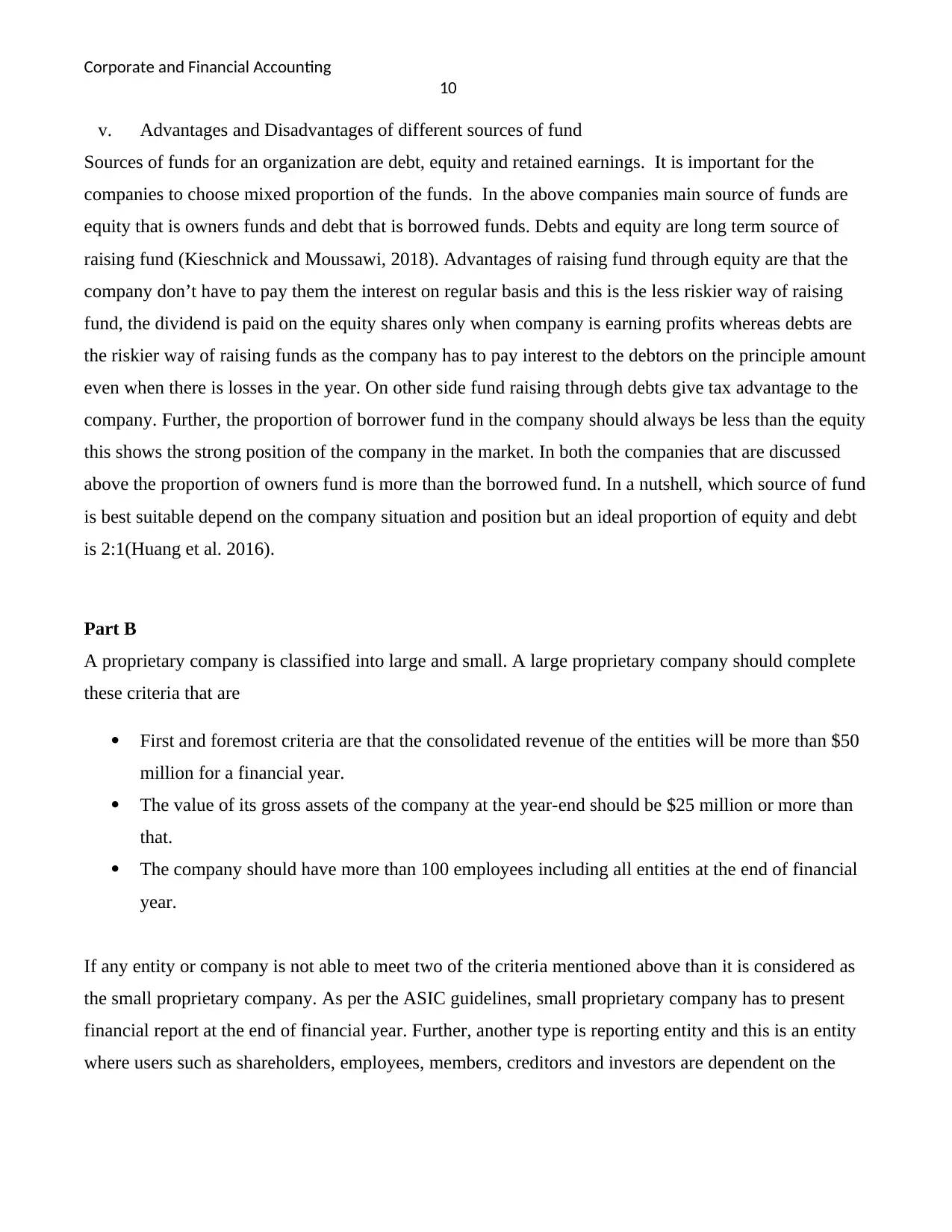
Corporate and Financial Accounting
10
v. Advantages and Disadvantages of different sources of fund
Sources of funds for an organization are debt, equity and retained earnings. It is important for the
companies to choose mixed proportion of the funds. In the above companies main source of funds are
equity that is owners funds and debt that is borrowed funds. Debts and equity are long term source of
raising fund (Kieschnick and Moussawi, 2018). Advantages of raising fund through equity are that the
company don’t have to pay them the interest on regular basis and this is the less riskier way of raising
fund, the dividend is paid on the equity shares only when company is earning profits whereas debts are
the riskier way of raising funds as the company has to pay interest to the debtors on the principle amount
even when there is losses in the year. On other side fund raising through debts give tax advantage to the
company. Further, the proportion of borrower fund in the company should always be less than the equity
this shows the strong position of the company in the market. In both the companies that are discussed
above the proportion of owners fund is more than the borrowed fund. In a nutshell, which source of fund
is best suitable depend on the company situation and position but an ideal proportion of equity and debt
is 2:1(Huang et al. 2016).
Part B
A proprietary company is classified into large and small. A large proprietary company should complete
these criteria that are
First and foremost criteria are that the consolidated revenue of the entities will be more than $50
million for a financial year.
The value of its gross assets of the company at the year-end should be $25 million or more than
that.
The company should have more than 100 employees including all entities at the end of financial
year.
If any entity or company is not able to meet two of the criteria mentioned above than it is considered as
the small proprietary company. As per the ASIC guidelines, small proprietary company has to present
financial report at the end of financial year. Further, another type is reporting entity and this is an entity
where users such as shareholders, employees, members, creditors and investors are dependent on the
10
v. Advantages and Disadvantages of different sources of fund
Sources of funds for an organization are debt, equity and retained earnings. It is important for the
companies to choose mixed proportion of the funds. In the above companies main source of funds are
equity that is owners funds and debt that is borrowed funds. Debts and equity are long term source of
raising fund (Kieschnick and Moussawi, 2018). Advantages of raising fund through equity are that the
company don’t have to pay them the interest on regular basis and this is the less riskier way of raising
fund, the dividend is paid on the equity shares only when company is earning profits whereas debts are
the riskier way of raising funds as the company has to pay interest to the debtors on the principle amount
even when there is losses in the year. On other side fund raising through debts give tax advantage to the
company. Further, the proportion of borrower fund in the company should always be less than the equity
this shows the strong position of the company in the market. In both the companies that are discussed
above the proportion of owners fund is more than the borrowed fund. In a nutshell, which source of fund
is best suitable depend on the company situation and position but an ideal proportion of equity and debt
is 2:1(Huang et al. 2016).
Part B
A proprietary company is classified into large and small. A large proprietary company should complete
these criteria that are
First and foremost criteria are that the consolidated revenue of the entities will be more than $50
million for a financial year.
The value of its gross assets of the company at the year-end should be $25 million or more than
that.
The company should have more than 100 employees including all entities at the end of financial
year.
If any entity or company is not able to meet two of the criteria mentioned above than it is considered as
the small proprietary company. As per the ASIC guidelines, small proprietary company has to present
financial report at the end of financial year. Further, another type is reporting entity and this is an entity
where users such as shareholders, employees, members, creditors and investors are dependent on the
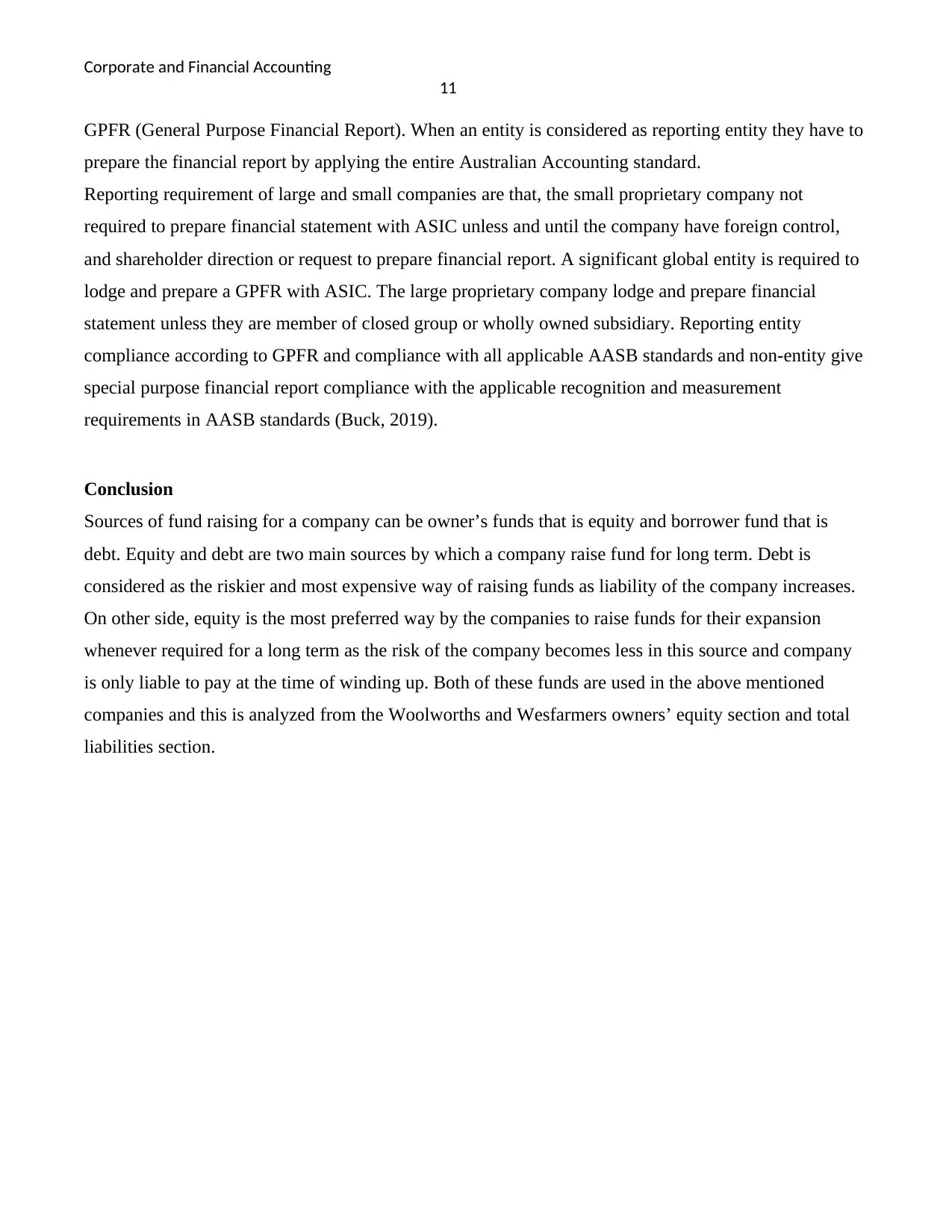
Corporate and Financial Accounting
11
GPFR (General Purpose Financial Report). When an entity is considered as reporting entity they have to
prepare the financial report by applying the entire Australian Accounting standard.
Reporting requirement of large and small companies are that, the small proprietary company not
required to prepare financial statement with ASIC unless and until the company have foreign control,
and shareholder direction or request to prepare financial report. A significant global entity is required to
lodge and prepare a GPFR with ASIC. The large proprietary company lodge and prepare financial
statement unless they are member of closed group or wholly owned subsidiary. Reporting entity
compliance according to GPFR and compliance with all applicable AASB standards and non-entity give
special purpose financial report compliance with the applicable recognition and measurement
requirements in AASB standards (Buck, 2019).
Conclusion
Sources of fund raising for a company can be owner’s funds that is equity and borrower fund that is
debt. Equity and debt are two main sources by which a company raise fund for long term. Debt is
considered as the riskier and most expensive way of raising funds as liability of the company increases.
On other side, equity is the most preferred way by the companies to raise funds for their expansion
whenever required for a long term as the risk of the company becomes less in this source and company
is only liable to pay at the time of winding up. Both of these funds are used in the above mentioned
companies and this is analyzed from the Woolworths and Wesfarmers owners’ equity section and total
liabilities section.
11
GPFR (General Purpose Financial Report). When an entity is considered as reporting entity they have to
prepare the financial report by applying the entire Australian Accounting standard.
Reporting requirement of large and small companies are that, the small proprietary company not
required to prepare financial statement with ASIC unless and until the company have foreign control,
and shareholder direction or request to prepare financial report. A significant global entity is required to
lodge and prepare a GPFR with ASIC. The large proprietary company lodge and prepare financial
statement unless they are member of closed group or wholly owned subsidiary. Reporting entity
compliance according to GPFR and compliance with all applicable AASB standards and non-entity give
special purpose financial report compliance with the applicable recognition and measurement
requirements in AASB standards (Buck, 2019).
Conclusion
Sources of fund raising for a company can be owner’s funds that is equity and borrower fund that is
debt. Equity and debt are two main sources by which a company raise fund for long term. Debt is
considered as the riskier and most expensive way of raising funds as liability of the company increases.
On other side, equity is the most preferred way by the companies to raise funds for their expansion
whenever required for a long term as the risk of the company becomes less in this source and company
is only liable to pay at the time of winding up. Both of these funds are used in the above mentioned
companies and this is analyzed from the Woolworths and Wesfarmers owners’ equity section and total
liabilities section.
⊘ This is a preview!⊘
Do you want full access?
Subscribe today to unlock all pages.

Trusted by 1+ million students worldwide
1 out of 13